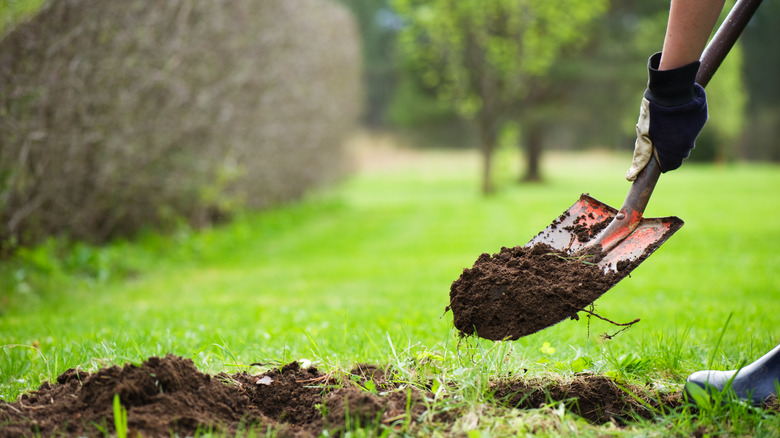Give Trees A Healthy Kickstart With This Simple Planting Technique
Planting a tree on your property has many benefits, including providing shade, boosting curb appeal, and giving the wildlife a habitat. If you're going to invest time and money in a new tree for your yard, set it up with the best chance for success with this planting technique. It's so easy to make mistakes when planting a tree, so save yourself some hard-earned money and heartache by planting your tree the best way possible right from the start. Experts at Colorado State University suggest planting new trees in saucer-shaped holes. They state that the main reason newly-planted trees don't thrive is that they don't get enough oxygen.
Trees experience post-planting stress, and creating the best conditions for strong root growth is key. This wide hole with curved sides is an easy trick to give you a healthy, long-lived tree. A disk-shaped hole will make your new tree happy. The depth and shape allow the roots to breathe and absorb water efficiently. The disk shape keeps liquid from pooling inside the hole and lets the roots take full advantage of this vital resource. Top-heavy trees seem like they'd appreciate a deep hole for lots of support around their trunks. That's not the case, as 90% or more of trees' roots grow in the top 3 feet of their surrounding soil. Around 50% of the roots only reach down about one foot. The width gives the roots essential space to spread out and develop a strong support system.
What is the perfect hole for a tree?
Start by measuring the root ball. You'll dig a hole about 2 to 4 inches shallower than the depth of the root ball. Tree roots need a lot of space to spread out horizontally. The hole should be much wider than it is deep at about three times the diameter of the root ball. You may need to loosen compact soil around the hole to make it easier for the roots to establish themselves. Prepping your yard's soil before planting a tree is time well spent.
Once your hole is about three times the width of the root ball and a few inches shy of the ball's depth, add a bit of compost to give the tree a nutrient boost. Setting the tree in the hole before removing the wrapping from the root ball makes moving the plant easier. Curve the sides of the hole to make the saucer shape, and begin filling the hole. Don't mound the soil over the very tops of the root ball. Water it thoroughly, and add a bit more soil if the water tamps it down beyond the very top of the root ball. Surround the tree base with organic mulch to help hold in moisture without choking the tree. Despite the common tree planting practice of staking your tree, it may not be necessary. Water your new tree one to three times a week until fall, depending on your climate and the tree's specific needs.

